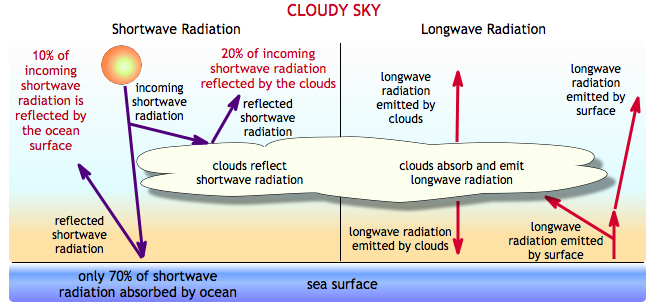
|

|


Clouds and Climate
How do clouds affect the temperature you feel at the Earth's surface? Now imagine that some clouds develop. On average, clouds reflect 20% of the incoming solar radiation, but the actual amount of individual clouds can vary. For example, thin clouds have an albedo of 30 to 50%, while thick clouds can have an albedo of up to 90%. So, on average, only 70% of the solar radiation reaches the sea surface. As in the clear sky case, the warmed surface re-emits longwave radiation. The clouds, much like the greenhouse gases, absorb and re-emit longwave radiation and this is a slight warming effect of clouds. However, for thick, low clouds, the cooling from the shortwave effect is greater than the warming for the longwave effect. An exception is at night, when there is no incoming solar radiation. In this case, the low clouds trap radiation being emitted by the Earth's surface and keep it warm. The story is a little different for high clouds. High clouds are usually thin and wispy, and so most of the Sun's radiation reaches the Earth's surface. The clouds emit radiation at a much colder temperature than the Earth's surface, because they are so high in the sky. Therefore, less radiation is escaping the Earth's atmosphere than if the clouds weren't there. This is why overall, high clouds have a warming effect.
 Next page
->
How does the climate affect clouds?
Links and resources
Next page
->
How does the climate affect clouds?
Links and resources
How do clouds affect the temperature you feel at the Earth's surface? Now imagine that some clouds develop. On average, clouds reflect 20% of the incoming solar radiation, but the actual amount of individual clouds can vary. For example, thin clouds have an albedo of 30 to 50%, while thick clouds can have an albedo of up to 90%. So, on average, only 70% of the solar radiation reaches the sea surface. As in the clear sky case, the warmed surface re-emits longwave radiation. The clouds, much like the greenhouse gases, absorb and re-emit longwave radiation and this is a slight warming effect of clouds. However, for thick, low clouds, the cooling from the shortwave effect is greater than the warming for the longwave effect. An exception is at night, when there is no incoming solar radiation. In this case, the low clouds trap radiation being emitted by the Earth's surface and keep it warm. The story is a little different for high clouds. High clouds are usually thin and wispy, and so most of the Sun's radiation reaches the Earth's surface. The clouds emit radiation at a much colder temperature than the Earth's surface, because they are so high in the sky. Therefore, less radiation is escaping the Earth's atmosphere than if the clouds weren't there. This is why overall, high clouds have a warming effect.

